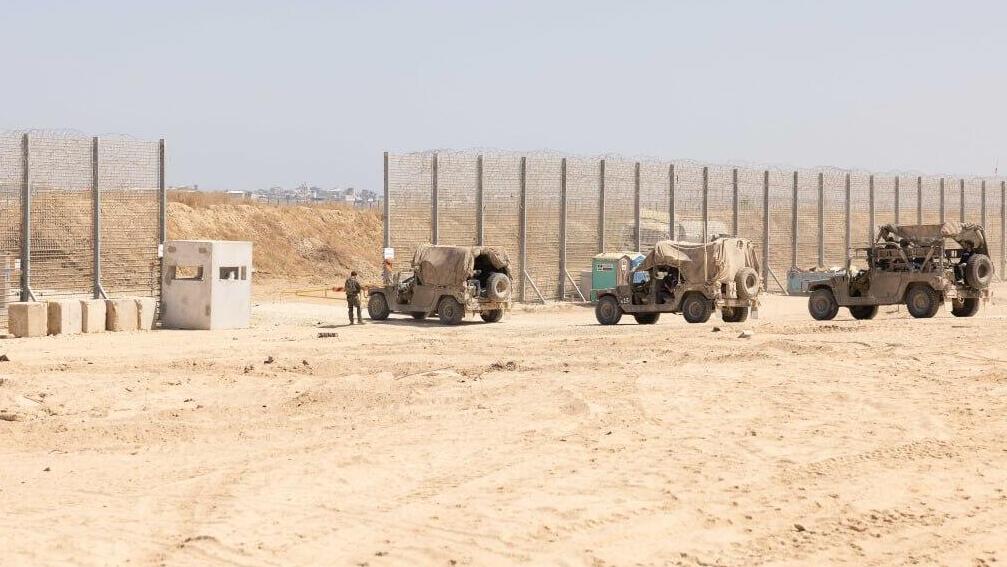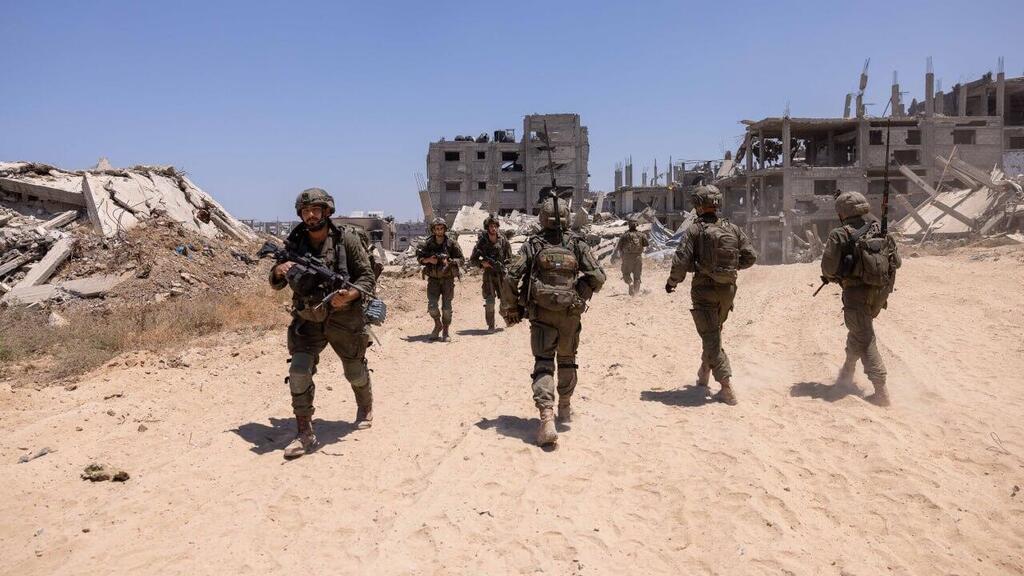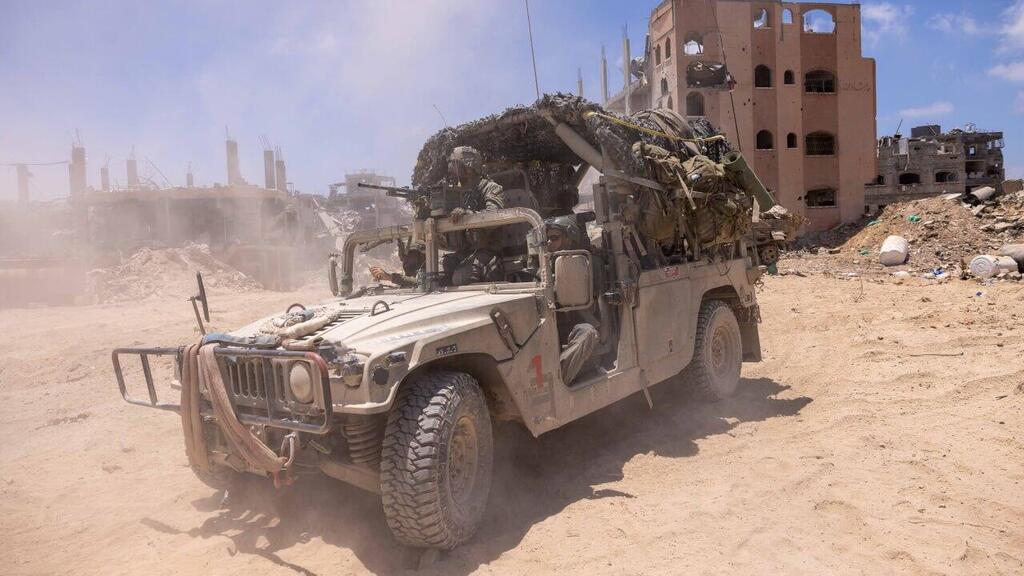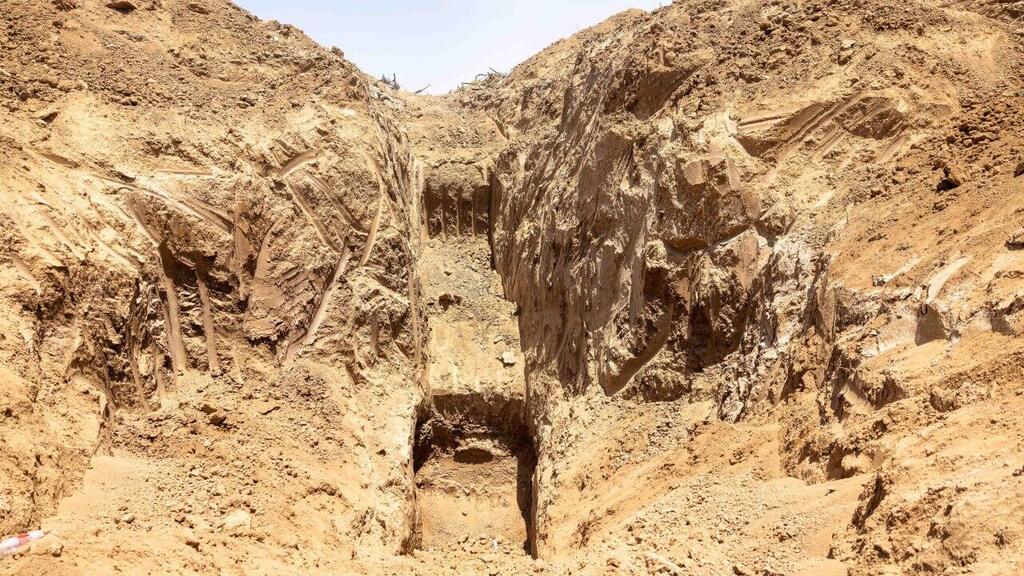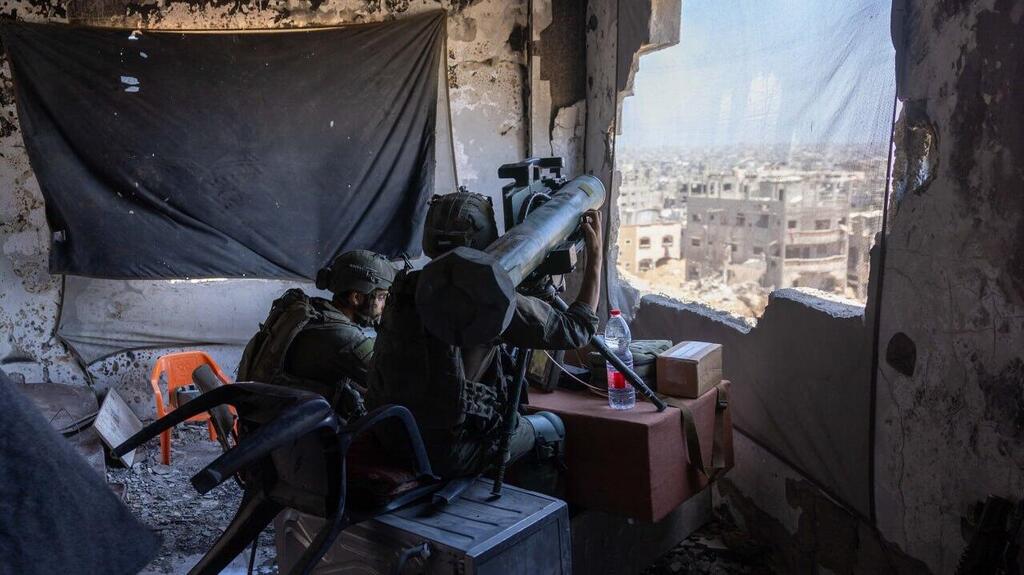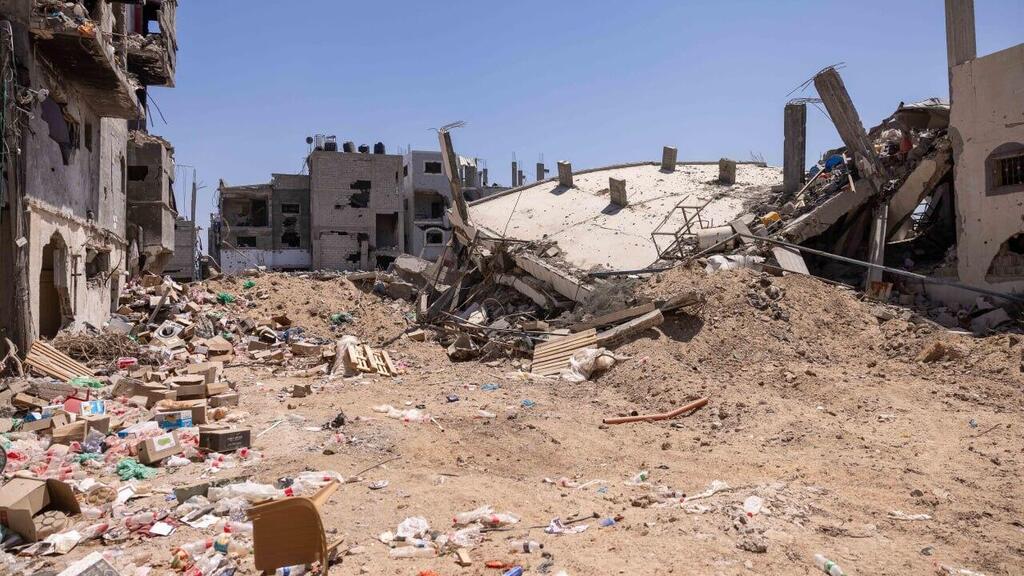Getting your Trinity Audio player ready...
Some 1,800 meters and a 6-minute ride in the Paratroopers' Hummer separates the westernmost line of houses of Kibbutz Nahal Ozfrom the easternmost line of houses of the Shijaiyah neighborhood. The IDF had not operated in the hostile Gaza neighborhood for six months, since the 36th Division finished maneuvering there, and still, signs of getting used to such raid fighting are evident in our hosts from the very beginning.
"It no longer excites me to cross the border fence like this," says Sergeant Amalaki Takala, who operates the Negev machine gun for battalion 202, who lets us in to the armored vehicle. "It gives me the same feeling as if I'm entering the neighborhood where I live".
And yet, at the moment of the crossing, the soldier loads his ammunition magazines into the state-of-the-art machine gun he recently received, the Negev 7, and is proud to say that his new machine gun penetrates more and is more deadly, because of the diameter of the bullets.
On a good day you can also see from here the buildings of the city where Amalaki fought on October 7 with his friends - Sderot.
The remains of crushed and dusty car skeletons are still lying on the side of the road that rises up between the Nahal Oz outpost and the attack area of the paratroopers in the Shijaiyah neighborhood, on the 80th Ridge. The low ridge is so named because of its height: It is only 80 meters high, but that is high enough to control the fire and to observe Kibbutz Nahal Oz, Kfar Aza and a few others. The ridge also hides, almost providing a buffer, between the Western Negev and the neighborhoods deep in Gaza, from Zeitoun to Sheikh Ijlin and Rimal, where a new attack began Tuesday to increase the pressure on Hamas. On the morning of October 7, hundreds of terrorists from the Shijaiyah Battalion, one of the toughest and most brutal in Hamas, rushed in through this route into the nearby kibbutzes. They didn't even need vehicles. This is running distance.
In the first months of the war, the IDF had already leveled some of the buildings here, in order to establish the buffer zone that would separate the Israeli communities from the nearby Gaza neighborhoods - but not all of them.
7 View gallery
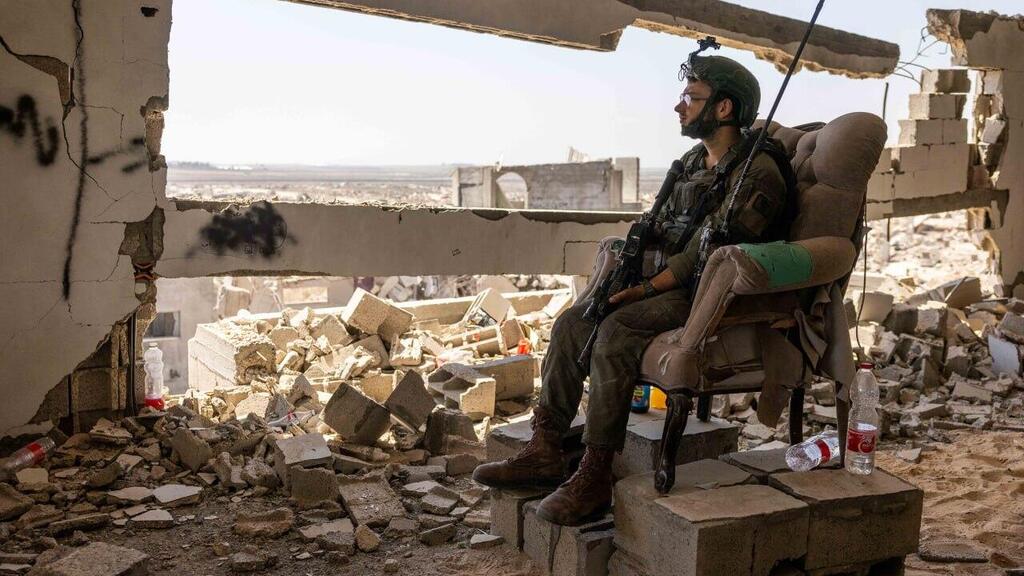

IDF soldier in bombed out building in Shijaiyah, looking toward the neighborhood of Daraj Tuffah
(Photo: Tal Shahar)
Our first stop is the battalion headquarters, and from the third floor that the IDF recaptured here, you can easily fire a volley from a heavy machine gun on the kibbutz houses in front of us. The wall to the east of the kibbutzim is completely dismantled, and only the silhouette of a paratrooper, sitting on an elevated armchair, hides part of the view of the flat fields. But the soldier is actually looking to the north, through two openings in the walls toward the neighborhood of Daraj Tuffah, where the IDF is not currently operating, and which is also waiting its turn for a repeat raid by the IDF forces. Hamas snipers are deployed there.
IDF troops operate and Hamas fighters use a drone
The forces of the 98th Division, led by two brigades, the paratroopers and the 7th Armored Division, reinforced by a battalion from the Givati brigade, have been operating in Shijaiyah for about two weeks, but the reception they received led to concern or at least an understanding of how Hamas is trying to rehabilitate itself militarily.
Hamas operatives who returned to the neighborhood managed to launch a drone after the arrival of the fighters, and record them from above, all within a few kilometers of the kibbutzim. If Hamas managed to send a drone into a neighborhood taken over by the IDF in a maneuver about six months ago, to record the forces and produce a threatening psychological warfare clip from it, this means that there is still a lot of work to be done, even as the raid here is set to end soon.
"We analyzed this video to understand from where Hamas launched the drone, where its squads are, as well as to create our correct attack routes toward them," says the commander of the battalion's fire company established during the war, Major Paz.
"We realized that Hamas moves quietly at night, sometimes without being detected, then attacks during the day with small squads, also defenders of our forces and houses where the soldiers were located. This was mainly the case at the beginning. Today, they fired mortars in our direction but we have many successful detections and countermeasures - through the team here in the room, with the screens projecting what our various drones are identifying from the sky, we have located two terrorists in the last hour who were eliminated, aAnd the soldiers here provide ammunition solutions for targets at the brigade and division level as well."
In general, the lower the rank of the interviewee, the higher is their modesty. "How many have we killed here?" Maj. Gen. Schneider answers me with a question, as he tries to calculate the number. "About 12 terrorists, my battalion alone, in the two weeks we've been here," he answers. They have already fired a number of such missiles that travel from a distance and do not require a direct line of sight to the target. Their firing is horizontal, unlike the vertical drones, thus enabling a double grip on the enemy, but the enemy has already realized this.
Black sheets that tend to fly in the light breeze cover the opening that Hamas created on the ground floor of a four-story building. The building is half-destroyed, like the rest of the destroyed buildings on the abandoned street here that the IDF occupied for the second time last month. Hamas placed this fighting position inside, into the street, and not outside, to try and surprise the soldiers who would enter here in a raid. Inside, the paratroopers found Kalashnikov rifles, RPG shells, a lot of ammunition, some charges and Hamas combat rations for a long stay.
"This time we also discovered our shells, which did not explode, and they were the ones that Hamas operatives collected and used as raw material, and also to prepare explosions against us," explains Battalion 202 Commander Lt. Col. Schneider and mentions a frustrating fact: A large part of Hamas' explosive weapons is made from IDF explosives collected from Air Force bombs that did not explode in the Strip over the years.
The Islamic Jihad flagship tunnel - 2.5 km long
Schneider has been in the job for two weeks, thrown directly into the hot cauldron of a hostile Shijaiyah. Before that, he was the commanding officer of the Paratrooper Brigade, and after two months of fighting, he went on to complete the requirements to become an IDF Major General: a master's degree (in political science) and a General Major course. Gaza was waiting for his return.
"Look how important it is that we be here and act here," he says, pointing from the top of the Palestinian structure to the large red pyramid antenna in the center of Kibbutz Nahal Oz, "We are here to prevent the reestablishment of Hamas, and wherever it returns we will also return. We operate here and attack according to 'harassment orders' with our fire and 'extermination orders' in order to push the enemy west." But their main mission here does not concern the terrorists or the positions they have reestablished.
A huge pit opened in the brown soil, scratched by quarrying tracks from an IDF engineering drill, greets us just before returning to Israeli territory. As in nearby Jabaliya, here too the IDF operation did not damage, or did not find, a large part of Hamas' assets. This is an attack tunnel to Israel that ends near the border fence, which the forces here found in the last few days. And this is the main goal of the raid here: locating and destroying Hamas tunnels from the hostile neighborhood that borders the kibbutzim. For the last six months, when the IDF was not here, Hamas was left with their terrorist tunnels. Although they do not cross into Israeli territory, they do come close. The IDF found out about them from the intelligence materials it collected and analyzed during its operations in the Gaza Strip and from the investigations of arrested Hamas operatives.
"We attacked this tunnel in the past and a branch of it was used by the kidnappers of the body of the late Golani soldier Oron Shaul, during Operation Protective Edge 10 years ago," a paratrooper officer says. "It happened exactly 150 meters from here. We don't know If Hamas has used it in recent months and we are looking for more of these. The purpose of this tunnel is to get closer to the border or to go up to Shijaiyah, also the more inner neighborhoods of Gaza City."
According to officials from Division 98, which is leading the operation, about 100 terrorists have been killed so far in the raid, most of them in the command and control center that Hamas re-established in the west of the neighborhood, which included security forces sheltering among a thousand civilians in nearby Zeitoun and Daraj, and tried to launch explosive drones and mortars from there on the soldiers. The data also shows that the forces found 2.5 kilometers of a flagship tunnel of Islamic Jihad in the neighborhood, and six more terror tunnels, while the division estimates that at least three more will be discovered.
Another round in Gaza, and you wonder: 'When will we enter Lebanon?'
Pink boxes of good-quality tuna with pieces of carrot and peas, hundreds of bags of raw couscous and french fries, and countless bottles of mineral water are laid out on the mounds of sand and the surfaces of the ground between the buildings that the IDF occupied. The logistics here are excellent, the commanders testify, but This is not a good reason to throw the expensive food on the hot ground. The proximity to the border with Israel made it possible to bring hot and cooked meals directly into the enemy's territory. The routine in Gaza has become comfortable. "You sneeze and poof, it's over, and it will be September. The time in service here flies," testifies Lt. Ben Ami, team commander of the battalion's ultra-Orthodox Arrow company, which is now attached to the battalion commander's command post.
Two weeks ago we talked on the phone about the ultra-Orthodox company that entered even though it lost its company commander in an encounter and five soldiers within 30 hours, in Jabaliya about a month and a half ago. "Another round in Gaza" is the nickname here for the raid. You enter for two weeks to a month of action on the ground, then go for refreshment of a week or two with a two-three day leave at home, and - God forbid - return. There are soldiers here who also went on regular leave during the war.
"It's already starting to tickle us to enter Lebanon as well; it's unimaginable what's happening there, 80,000 Israelis evacuated from their homes without a single Hezbollah operative entering the country. Obviously, it's better for us to be here on the offensive and not on the defensive there at the border like Golani, but the soldiers are starting to ask, 'When will we enter Lebanon already?' and 'When will we also fight Hezbollah?'" says Lt. Ben Ami.
Maj. Gen. Schneider admits that fighting for such a long time in the Strip produces a certain degeneration for the soldiers, and not just natural attrition. He estimates that his forces will need at least a month of training and preparations for combat in Lebanon, against a different enemy and in a completely different terrain. In any scenario of a war with Hezbollah, Division 98, the elite division of the IDF, and within it the paratroopers, will have a very significant role.
"What are those two muffled explosions?" I ask. "It's the mounds of Kalashnikovs we found today, we destroyed them on the ground because we haven't been releasing enemy loot into the country for a long time, since the warehouses have long since been filled," Schneider replies. "Pretty quickly you learn to distinguish between terrorist fire and rocket launchers - like we had here half an hour ago, and our explosions."
Sergeant Yosef Cohen from Jerusalem, summarizes perhaps in the most striking way the many years of fighting that awaits the soldiers here, regular and reserve: "At first I felt very strange leaving Gaza and suddenly seeing whole sidewalks, paved roads, trees in the neighborhood, cars moving, running water in the shower and toilet, electricity that is turned on in the room. Now there is no longer that shock when you return home to Israel, I've gotten used to it."



